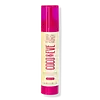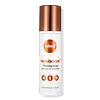What's inside
What's inside
 Key Ingredients
Key Ingredients

 Benefits
Benefits

 Concerns
Concerns

 Ingredients Side-by-side
Ingredients Side-by-side

Water
Skin ConditioningDihydroxyacetone
Skin ConditioningPropanediol
SolventErythrulose
TanningHylocereus Undatus Fruit Extract
Skin ConditioningJuglans Regia Shell Extract
Skin ConditioningMusa Sapientum Fruit Extract
Skin ConditioningCocos Nucifera Fruit Extract
EmollientHyaluronic Acid
HumectantHydrolyzed Hyaluronic Acid
HumectantSodium Hyaluronate
HumectantSodium Hyaluronate Crosspolymer
HumectantHydrolyzed Glycosaminoglycans
HumectantTocopherol
AntioxidantCitrus Nobilis Peel Oil
MaskingHelianthus Annuus Seed Oil
EmollientPolyglyceryl-6 Caprylate/Caprate
StabilisingPolyglyceryl-4 Laurate/Sebacate
SolventGlycerin
HumectantHydroxyethyl Acrylate/Sodium Acryloyldimethyl Taurate Copolymer
Emulsion StabilisingCitric Acid
BufferingParfum
MaskingPhenoxyethanol
PreservativeSodium Benzoate
MaskingPotassium Sorbate
PreservativeEthylhexylglycerin
Skin ConditioningSodium Metabisulfite
AntioxidantCI 16035
Cosmetic ColorantWater, Dihydroxyacetone, Propanediol, Erythrulose, Hylocereus Undatus Fruit Extract, Juglans Regia Shell Extract, Musa Sapientum Fruit Extract, Cocos Nucifera Fruit Extract, Hyaluronic Acid, Hydrolyzed Hyaluronic Acid, Sodium Hyaluronate, Sodium Hyaluronate Crosspolymer, Hydrolyzed Glycosaminoglycans, Tocopherol, Citrus Nobilis Peel Oil, Helianthus Annuus Seed Oil, Polyglyceryl-6 Caprylate/Caprate, Polyglyceryl-4 Laurate/Sebacate, Glycerin, Hydroxyethyl Acrylate/Sodium Acryloyldimethyl Taurate Copolymer, Citric Acid, Parfum, Phenoxyethanol, Sodium Benzoate, Potassium Sorbate, Ethylhexylglycerin, Sodium Metabisulfite, CI 16035
Water
Skin ConditioningGlycerin
HumectantCaprylic/Capric Triglyceride
MaskingButylene Glycol
HumectantMica
Cosmetic ColorantPvp
Emulsion StabilisingSodium Acrylates Copolymer
CI 77491
Cosmetic ColorantCI 77163
Cosmetic ColorantSynthetic Fluorphlogopite
Macrocystis Pyrifera Extract
Skin ConditioningCI 77947
Octyldodecanol
EmollientPhenoxyethanol
PreservativeSqualane
EmollientLecithin
EmollientEthylhexylglycerin
Skin ConditioningCI 77499
Cosmetic ColorantSodium Hyaluronate
HumectantCucumis Sativus Fruit Extract
EmollientTheobroma Cacao Seed Extract
AntioxidantSodium Benzoate
MaskingPisum Sativum Extract
Skin ConditioningPotassium Sorbate
PreservativeWater, Glycerin, Caprylic/Capric Triglyceride, Butylene Glycol, Mica, Pvp, Sodium Acrylates Copolymer, CI 77491, CI 77163, Synthetic Fluorphlogopite, Macrocystis Pyrifera Extract, CI 77947, Octyldodecanol, Phenoxyethanol, Squalane, Lecithin, Ethylhexylglycerin, CI 77499, Sodium Hyaluronate, Cucumis Sativus Fruit Extract, Theobroma Cacao Seed Extract, Sodium Benzoate, Pisum Sativum Extract, Potassium Sorbate
Ingredients Explained
These ingredients are found in both products.
Ingredients higher up in an ingredient list are typically present in a larger amount.
Ethylhexylglycerin (we can't pronounce this either) is commonly used as a preservative and skin softener. It is derived from glyceryl.
You might see Ethylhexylglycerin often paired with other preservatives such as phenoxyethanol. Ethylhexylglycerin has been found to increase the effectiveness of these other preservatives.
Glycerin is already naturally found in your skin. It helps moisturize and protect your skin.
A study from 2016 found glycerin to be more effective as a humectant than AHAs and hyaluronic acid.
As a humectant, it helps the skin stay hydrated by pulling moisture to your skin. The low molecular weight of glycerin allows it to pull moisture into the deeper layers of your skin.
Hydrated skin improves your skin barrier; Your skin barrier helps protect against irritants and bacteria.
Glycerin has also been found to have antimicrobial and antiviral properties. Due to these properties, glycerin is often used in wound and burn treatments.
In cosmetics, glycerin is usually derived from plants such as soybean or palm. However, it can also be sourced from animals, such as tallow or animal fat.
This ingredient is organic, colorless, odorless, and non-toxic.
Glycerin is the name for this ingredient in American English. British English uses Glycerol/Glycerine.
Learn more about GlycerinPhenoxyethanol is a preservative that has germicide, antimicrobial, and aromatic properties. Studies show that phenoxyethanol can prevent microbial growth. By itself, it has a scent that is similar to that of a rose.
It's often used in formulations along with Caprylyl Glycol to preserve the shelf life of products.
Potassium Sorbate is a preservative used to prevent yeast and mold in products. It is commonly found in both cosmetic and food products.
This ingredient comes from potassium salt derived from sorbic acid. Sorbic acid is a natural antibiotic and effective against fungus.
Both potassium sorbate and sorbic acid can be found in baked goods, cheeses, dried meats, dried fruit, ice cream, pickles, wine, yogurt, and more.
You'll often find this ingredient used with other preservatives.
Learn more about Potassium SorbateSodium Benzoate is a preservative. It's used in both cosmetic and food products to inhibit the growth of mold and bacteria. It is typically produced synthetically.
Both the US FDA and EU Health Committee have approved the use of sodium benzoate. In the US, levels of 0.1% (of the total product) are allowed.
Sodium benzoate works as a preservative by inhibiting the growth of bacteria inside of cells. It prevents the cell from fermenting a type of sugar using an enzyme called phosphofructokinase.
It is the salt of benzoic acid. Foods containing sodium benzoate include soda, salad dressings, condiments, fruit juices, wines, and snack foods.
Studies for using ascorbic acid and sodium benzoate in cosmetics are lacking, especially in skincare routines with multiple steps.
We always recommend speaking with a professional, such as a dermatologist, if you have any concerns.
Learn more about Sodium BenzoateSodium Hyaluronate is hyaluronic acid's salt form. It is commonly derived from the sodium salt of hyaluronic acid.
Like hyaluronic acid, it is great at holding water and acts as a humectant. This makes it a great skin hydrating ingredient.
Sodium Hyaluronate is naturally occurring in our bodies and is mostly found in eye fluid and joints.
These are some other common types of Hyaluronic Acid:
Learn more about Sodium HyaluronateWater. It's the most common cosmetic ingredient of all. You'll usually see it at the top of ingredient lists, meaning that it makes up the largest part of the product.
So why is it so popular? Water most often acts as a solvent - this means that it helps dissolve other ingredients into the formulation.
You'll also recognize water as that liquid we all need to stay alive. If you see this, drink a glass of water. Stay hydrated!
Learn more about Water